
Photo from academic.microsoft.com
The regioselectivity of the addition of HO-acids to the activated π bond in N,N-bis(oxy)enamines has been found to be dramatically dependent upon the solvent. Mechanistic investigations and quantum-chemical calculations revealed… Click to show full abstract
The regioselectivity of the addition of HO-acids to the activated π bond in N,N-bis(oxy)enamines has been found to be dramatically dependent upon the solvent. Mechanistic investigations and quantum-chemical calculations revealed that solvent affects the reaction pathway. In basic solvents (DMF, NMP, DMSO), N,N-bis(oxy)enamines were converted into nitrosoalkenes by a Lewis base promoted process followed by oxy-Michael addition of the HO-acid. In non-polar solvents (toluene, CH2Cl2), the reaction occurs by an acid-promoted SN′ substitution of the N-oxy-group via a highly reactive N-vinyl-N-alkoxynitrenium species. Based on these studies, general and efficient protocols for the oximinoalkylation of various HO-acids (carboxylic acids, phenols, hydroxamic, phosphoric and sulfonic acids) employing readily available N,N-bis(oxy)enamines were developed. These methods proved to be applicable to the post-modification of natural molecules bearing acidic OH groups (such as steroidal hormones, bile acids, protected amino acids and peptides) and ligands (BINOL). The resulting α-oxyoximes were demonstrated to be useful precursors of valuable 1,2-amino alcohol or 1,2-hydroxylamino alcohol derivatives, including the antiarrhythmic drug Mexiletine and a potent matrix metalloproteinase inhibitor.
Journal Title: European Journal of Organic Chemistry
Year Published: 2017
Link to full text (if available)
Share on Social Media: Sign Up to like & get
recommendations!